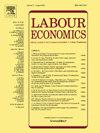了解产房的劳动生产率
IF 2.6
2区 经济学
Q2 ECONOMICS
引用次数: 0
摘要
本文提供了产房劳动生产率的因果估计。我们审议了一项意大利法律,该法律根据每年的出生人数规定了医院妇产部门的人员配备要求。我们利用法律中阈值导致的医务人员可用性的不连续性来定义工具变量和回归不连续性框架,使我们能够估计不同专业团队对分娩方式以及新生儿和分娩时母亲健康状况的因果影响。该分析基于意大利某地区详细的分娩患者数据。我们发现,年出生率高于阈值的产科单位更有可能在分娩时拥有“完整的专业团队”。我们发现,拥有一个完整的团队对分娩方式(剖腹产还是顺产)没有影响。但是,一个完整的小组的存在对健康结果有重大影响。我们发现,与更密集地使用医疗干预措施相关的新生儿和产妇结局都有所改善,这表明,在通过适当治疗避免并发症的分娩管理方面,大医院比小医院做得更好。此外,我们没有发现在一周中的几天、一天中的时间或母亲的国籍之间存在实质性的异质性影响。本文章由计算机程序翻译,如有差异,请以英文原文为准。
Understanding labour productivity in maternity wards
This paper provides a causal estimate of labour productivity in maternity wards. We consider an Italian law that defines the staffing requirements of hospital maternity units according to the annual number of births. We exploit the discontinuities in the availability of medical staff caused by thresholds in the law to define both instrumental variables and a regression discontinuity framework that allows us to estimate the causal effect of different teams of professionals on the mode of delivery and on the health status of newborns and mothers at delivery. The analysis is based on detailed patient-level data on births in an Italian region. We find that maternity units with annual births above the thresholds are more likely to have a 'full team' of professionals at delivery. We find that having a full team has no effect on the mode of delivery (caesarean section vs vaginal birth). However, the presence of a full team has a significant impact on health outcomes. We find an improvement in both neonatal and maternal outcomes associated with a more intensive use of medical interventions, suggesting that larger hospitals are better than smaller units at managing deliveries with appropriate treatments to avoid complications. In addition, we do not find substantial heterogeneous effects across days of the week, time of day, or nationality of mothers.
求助全文
通过发布文献求助,成功后即可免费获取论文全文。
去求助
来源期刊

Labour Economics
ECONOMICS-
CiteScore
3.60
自引率
8.30%
发文量
142
期刊介绍:
Labour Economics is devoted to publishing research in the field of labour economics both on the microeconomic and on the macroeconomic level, in a balanced mix of theory, empirical testing and policy applications. It gives due recognition to analysis and explanation of institutional arrangements of national labour markets and the impact of these institutions on labour market outcomes.
 求助内容:
求助内容: 应助结果提醒方式:
应助结果提醒方式:


